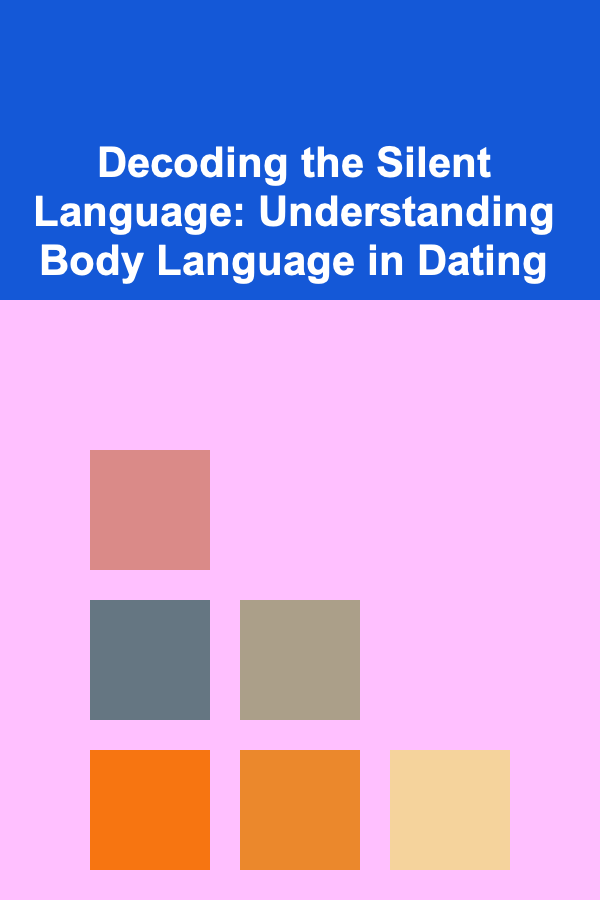
Decoding the Silent Language: Understanding Body Language in Dating
ebook include PDF & Audio bundle (Micro Guide)
$12.99$8.99
Limited Time Offer! Order within the next:

Dating is a complex dance of verbal and nonverbal communication. While carefully crafted words play a crucial role, the unspoken language of body language often speaks volumes, revealing true feelings, intentions, and levels of attraction. Mastering the art of interpreting body language can provide a significant advantage in the dating world, helping you navigate interactions with greater confidence, build stronger connections, and avoid potential pitfalls.
The Foundation: Why Body Language Matters in Dating
Body language constitutes a significant portion of our overall communication -- often estimated to be between 55% and 70%. This nonverbal communication is often subconscious, making it a more authentic indicator of a person's emotions and thoughts than their spoken words. In dating, where first impressions are paramount and genuine connection is the goal, understanding body language becomes indispensable. Here's why:
- Revealing Hidden Emotions: People might verbally express interest or confidence, but their body language can betray underlying nervousness, insecurity, or disinterest. Conversely, someone might be shy and hesitant with their words but demonstrate strong attraction through subtle nonverbal cues.
- Assessing Compatibility: Body language synchrony -- mirroring postures, gestures, and facial expressions -- is a powerful indicator of rapport and compatibility. Recognizing these subtle cues can help you gauge whether you and your date are truly connecting on a deeper level.
- Detecting Deception: While not foolproof, certain body language cues can indicate discomfort or dishonesty. Shifts in posture, excessive fidgeting, and micro-expressions can be red flags that warrant further investigation.
- Building Rapport and Connection: Consciously using positive body language can make you appear more approachable, confident, and engaging, fostering a stronger connection with your date.
- Avoiding Misunderstandings: Misinterpreting body language can lead to awkward situations and missed opportunities. A deeper understanding of nonverbal cues can help you avoid misreading signals and respond appropriately.
Key Elements of Body Language in Dating
Understanding body language requires paying attention to a variety of cues, from facial expressions to posture to proxemics (the use of personal space). Here's a breakdown of the key elements to observe:
Facial Expressions: The Window to the Soul
The face is a rich source of information, capable of conveying a wide range of emotions. While deliberate facial expressions can be faked, genuine emotions often manifest in fleeting micro-expressions that are difficult to consciously control. Pay attention to these key facial cues:
-
Eye Contact: Eye contact is arguably the most powerful form of nonverbal communication. Sustained, comfortable eye contact generally indicates interest and attentiveness. Avoidance of eye contact, on the other hand, can signal discomfort, shyness, or even dishonesty.
Sustained eye contact with occasional glances away to maintain comfort, rather than constantly looking around the room, indicates genuine interest.
-
Smiling: A genuine smile, known as a Duchenne smile, involves the contraction of both the zygomatic major muscle (which raises the corners of the mouth) and the orbicularis oculi muscle (which creates crow's feet around the eyes). A fake smile typically only involves the mouth and lacks the telltale crow's feet.
A Duchenne smile radiates warmth and sincerity, while a forced smile can feel insincere and unsettling.
-
Eyebrows: Raised eyebrows can indicate surprise, interest, or even flirting. Furrowed brows, on the other hand, can signal confusion, concern, or disapproval.
A slight raise of the eyebrows during conversation can signal engagement and attentiveness.
-
Lip Movements: Lip movements can reveal a variety of emotions. Lip biting can indicate nervousness or anxiety, while pursed lips can signal disagreement or disapproval.
Constantly biting the lip might indicate underlying nervousness or self-consciousness.
Posture: The Foundation of Confidence
Posture speaks volumes about a person's confidence, energy level, and openness. Observe the following postural cues:
-
Open vs. Closed Posture: An open posture involves keeping the torso and limbs uncrossed, signaling receptiveness and approachability. A closed posture, on the other hand, involves crossing arms or legs, creating a barrier and indicating defensiveness or discomfort.
Leaning forward with uncrossed arms conveys interest and engagement, while slouching with crossed arms can suggest disinterest or defensiveness.
-
Mirroring: Subconsciously mirroring another person's posture is a sign of rapport and connection. If you and your date are unconsciously mirroring each other, it suggests that you are on the same wavelength.
If you both lean forward slightly while listening to each other, this mirroring behavior suggests a positive connection.
-
Leaning: Leaning towards you generally indicates interest and engagement, while leaning away can signal disinterest or discomfort.
Subtly leaning in while your date is speaking shows you are actively listening and interested in what they have to say.
-
Head Position: Tilting the head can indicate interest and empathy, while a rigid head position can signal defensiveness or resistance.
Tilting the head slightly while listening can make you appear more attentive and empathetic.
Gestures: Emphasizing and Revealing
Gestures are movements of the hands, arms, and head that accompany speech. They can be used to emphasize points, illustrate ideas, or express emotions. Pay attention to the following gestures:
-
Hand Gestures: Open hand gestures generally indicate honesty and sincerity, while closed or fidgeting hand gestures can signal nervousness or anxiety.
Using open hand gestures while speaking conveys trustworthiness and openness.
-
Touch: Appropriate and well-timed touch can be a powerful way to build connection and signal interest. However, it's crucial to be mindful of boundaries and cultural norms. Unwanted or aggressive touching can be a major red flag.
A light touch on the arm or shoulder during conversation can be a subtle way to express interest, but be mindful of your date's comfort level.
-
Fidgeting: Excessive fidgeting, such as tapping fingers, bouncing legs, or playing with hair, can indicate nervousness, anxiety, or boredom.
Constantly tapping your foot might signal that you are feeling anxious or uncomfortable.
-
Nodding: Nodding indicates agreement and attentiveness. However, excessive nodding can appear insincere or desperate for approval.
Nodding occasionally to show you are listening and understanding is effective, but continuous, rapid nodding can appear unnatural.
Proxemics: The Language of Space
Proxemics refers to the use of personal space. The distance we maintain from others can indicate our level of comfort and intimacy. In dating, observe how your date positions themselves in relation to you:
- Intimate Distance (0-18 inches): This distance is typically reserved for close relationships, such as romantic partners and family members. Entering this space uninvited can be perceived as intrusive or aggressive.
- Personal Distance (1.5-4 feet): This is the distance we typically maintain with friends and acquaintances.
- Social Distance (4-12 feet): This distance is typically used for professional or formal interactions.
- Public Distance (12+ feet): This distance is used for public speaking or addressing large groups.
If your date moves closer to you, it can indicate interest and a desire for greater intimacy. Conversely, if they maintain a large distance or repeatedly back away, it might signal discomfort or disinterest. Pay attention to their comfort level and respect their personal space.
Context is Key: Interpreting Body Language Accurately
It's crucial to remember that body language is not a foolproof science. Interpreting nonverbal cues requires considering the context of the situation, the individual's personality, and cultural norms. Avoid making snap judgments based on a single gesture or expression. Instead, look for patterns and clusters of cues that support your interpretation.
Here are some factors to consider when interpreting body language:
- Cultural Background: Body language varies significantly across cultures. What is considered polite and respectful in one culture might be offensive or inappropriate in another. Be aware of cultural differences and avoid making assumptions based on your own cultural norms.
- Individual Personality: Some people are naturally more expressive than others. A shy person might avoid eye contact not because they are disinterested, but because they are simply uncomfortable with direct gaze. Consider the individual's personality and communication style when interpreting their body language.
- The Specific Situation: The context of the situation can significantly influence body language. A person might appear nervous or uncomfortable in a stressful situation, even if they are generally confident. Take into account the environment and any potential stressors when interpreting nonverbal cues.
- Look for Clusters of Cues: Don't rely on a single gesture or expression to make a judgment. Look for clusters of cues that support your interpretation. For example, if someone is leaning towards you, maintaining eye contact, and smiling, it's more likely that they are genuinely interested than if they are simply smiling.
Putting it All Together: Practical Tips for Decoding Body Language on a Date
Here are some practical tips for decoding body language on a date:
- Be Present and Observant: Put away your phone and focus on your date. Pay attention to their facial expressions, posture, gestures, and proxemics.
- Establish a Baseline: Observe your date's behavior when they are relaxed and comfortable. This will help you identify deviations from their normal behavior that might indicate a change in emotion or interest.
- Look for Consistency: Pay attention to how your date's body language aligns with their words. If their words say one thing but their body language says another, trust your instincts and investigate further.
- Trust Your Gut: Your intuition can be a powerful tool for interpreting body language. If something feels off, trust your gut and explore your concerns.
- Don't Overanalyze: While it's important to be observant, avoid overanalyzing every gesture and expression. Relax and enjoy the date.
- Practice Active Listening: Active listening involves paying attention to both the verbal and nonverbal cues of your date. Show them that you are engaged and interested in what they have to say.
- Be Mindful of Your Own Body Language: Project confidence, openness, and warmth through your own body language. Maintain eye contact, smile, and use open gestures.
The Dark Side: Manipulative Body Language
It's important to be aware that body language can be consciously manipulated. Some individuals may use body language tactics to deceive, manipulate, or exert control. Be wary of the following red flags:
- Excessive Eye Contact: While eye contact is generally a sign of interest, excessive or intense eye contact can be a manipulation tactic used to intimidate or dominate.
- Mirroring Used Strategically: While natural mirroring indicates rapport, consciously mimicking another person's behavior can be a manipulation tactic used to build false rapport and gain trust.
- Invasion of Personal Space: Deliberately invading your personal space can be a power play used to make you feel uncomfortable or vulnerable.
- False Displays of Empathy: Some individuals may fake empathy by mimicking empathetic expressions or gestures, even if they don't genuinely feel those emotions.
If you suspect that someone is using manipulative body language, trust your instincts and proceed with caution. It's important to prioritize your own safety and well-being.
Conclusion: Mastering the Art of Nonverbal Connection
Understanding body language is an invaluable skill in the dating world. By paying attention to the subtle cues of facial expressions, posture, gestures, and proxemics, you can gain a deeper understanding of your date's true feelings, intentions, and levels of attraction. Remember that context is key, and avoid making snap judgments based on a single gesture or expression. Practice active listening, be mindful of your own body language, and trust your gut. By mastering the art of nonverbal communication, you can navigate the dating landscape with greater confidence, build stronger connections, and find genuine, lasting love.

How to Create a Vintage Recipe Book from Collected Cards
Read More
How to Find the Best Deals When Buying Used Books and Textbooks Online
Read More
How To Launch a Podcasting Service for Businesses
Read More
How to Make Family Yoga Sessions Fun and Engaging
Read More
How To Understand Color Mixing for Painters
Read More
How To Learn to Troubleshoot Instrument Issues
Read MoreOther Products

How to Create a Vintage Recipe Book from Collected Cards
Read More
How to Find the Best Deals When Buying Used Books and Textbooks Online
Read More
How To Launch a Podcasting Service for Businesses
Read More
How to Make Family Yoga Sessions Fun and Engaging
Read More
How To Understand Color Mixing for Painters
Read More